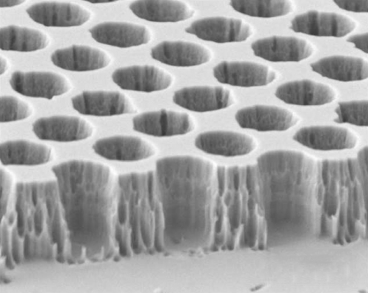A group of researchers at MIT has developed a method of creating a high-temperature version of photonic crystals by using metals like tantalum or tungsten. Proficient to operate at temperatures up to 120000C, the new materials can employ portable electronic device-based applications, spacecraft to probe deep space, and new infrared light emitters functioning as sensors and chemical detectors.
 A microscope image of the tungsten photonic crystal structure reveals the precise uniform spacing of cavities formed in the material, which are tuned to specific wavelengths of light.
A microscope image of the tungsten photonic crystal structure reveals the precise uniform spacing of cavities formed in the material, which are tuned to specific wavelengths of light.
The paper was co-authored by MIT professors Marin Soljaèiæ and John Joannopoulos, graduate students Walker Chen and Yi Xiang Yeng, in association with former postdoc Peter Bermel and Michael Ghebrebrhan.
A customized nanoengineered material was designed for the infrared range. The entire photonic crystals consist of a lattice of a particular material was merged with a complementary material or open spaces. This facilitates selective transmission of light with certain wavelengths and when used as emitters, they radiate certain wavelengths.
High temperature-efficient Photonic crystals offer various potential applications, including radioisotope-powered devices, components to acquire energy from waste heat at powerplants or industrial facilities, devices for solar-chemical or solar-thermal conversion, and hydrocarbon-powered generators. In order to overcome the challenges caused by high temperatures such as corrosion, diffusion, cracking, evaporation, melting or rapid chemical reactions of the crystals’ nanostructure, the team at MIT team formulated a structure from high-purity tungsten, using a specialized geometry to promote safety during high-temperature operation.
This research will also be supported by NASA that will provide the radioisotope thermal generators (RTGs), which harness the radioactive material’s power.
According to Celanovic, a research engineer at MIT’s Institute for Soldier Nanotechnologies, the portable electronic devices can operate on thermophotovoltaic generators. The same photonic crystal, besides generating power, also enables the creation of precisely tuned wavelengths of infrared light.
Supports for the research include MIT Energy Initiative seed grant, TeraGrid resources and the MIT S3TEC Energy Research Frontier Center of the U.S. Department of Energy Army Research Office via the Institute for Soldier Nanotechnologies, and NASA.